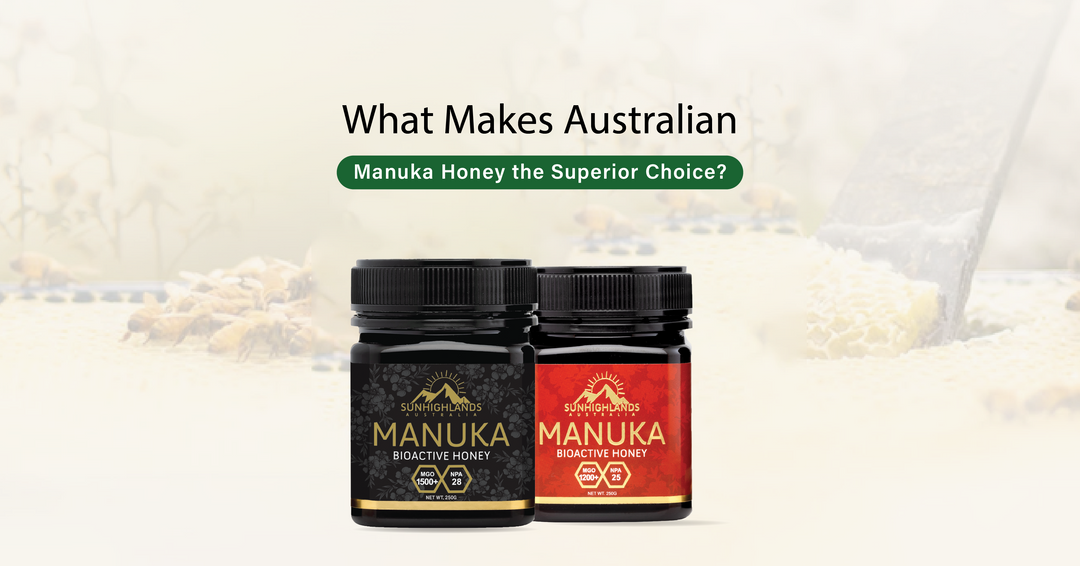Revealing Secrets: How to Test Pure Honey Fast at Home

Manuka honey is celebrated for its health benefits, from healing wounds to boosting immunity and soothing digestive issues. Yet, with its rising popularity, the market has seen a surge in counterfeit products that can dilute its benefits.
Honey is a healthy natural sweetener known for its taste and health benefits. But did you also know that not all honey is pure honey? Honey can sometimes be diluted with sugar or other substances. If you want to ensure you get the genuine article, here are some simple tests for honey purity that you can do at home.
The Senses Approach: How Your Five Senses Can Help Identify Pure Honey
1.Taste:
- Pure Honey: Expect a complex, rich flavour with subtle notes that reflect its botanical source. Manuka honey, in particular, has a robust, earthy, slightly bitter taste that lingers.
- Fake Honey: Often dominated by an overpowering sweetness, lacking depth or complexity.
2.Sight:
- Pure Honey is generally thick, dense, and dark. It may crystallise over time, resulting in a grainy texture.
- Fake Honey: Typically clear, runny, and uniform, suggesting added syrups or over-processing.
3.Smell:
- Pure Honey: A natural, floral aroma is typical, reflecting the source plants.
- Fake Honey: May smell overly sweet or synthetic due to artificial additives or excessive processing.
4.Touch:
- Pure Honey: When rubbed between fingers, it feels slightly sticky and, if crystallised, a bit grainy.
- Fake Honey: Feels watery or slippery, indicating impurities or dilution.
5.Hearing:
- Word of Mouth: Reviews and recommendations can provide insights into a product’s authenticity. Trust brands with a history of positive feedback and satisfied customers.
General Honey Purity Testing
- To begin, here are answers to a few frequently asked questions:
Are pure honey and raw honey the same thing?
No, since raw honey is unprocessed, it may also contain pollen. Pure Manuka Honey is honey that has no additional sugar or syrup added.
Is honey flammable?
Yes, honey is flammable, too, and it is exceptionally pure honey with its high sugar content.
Honey Test at Home
When testing honey, start with its consistency. Honey, in its original form, is viscous and will not dash. Runny honey may not be pure, so be on the lookout for this.
Another simple test is the colour check. Pure honey is typically golden or amber; fake honey sometimes looks clearer or lighter.
Water Test for Honey Purity
- Using the water test is one of the simplest tests to check the purity of honey.
Method 1
Take a glass of water and a spoonful of honey. Pure honey will drop to the bottom and remain in a lump. It may be blended with other ingredients if it dissolves quickly or spreads out.
Method 2
Fill a glass with water. Spoon some honey into the glass. Give it a gentle stir -- and see how the honey behaves. If it remains whole, it’s untainted. If it dissolves rapidly, it ain’t the real thing.
Identifying Pure Honey
You can also identify pure honey by its texture. Honey is meant to be viscous and viscous. Honey that is dissolved is probably not 100% fresh honey. The appearance of crystallization is another thing to watch for. Pure honey crystallizes and becomes thick over time, while fake honey remains liquid.
Style is also a pretty good guide. Pure honey is not sickly sweet like corn syrup; it has a distinctive floral taste. If it tastes more like sugar syrup, it’s probably not pure.
How to Test Original Honey
- Consistency: Natural honey is denser and viscous and doesn’t flow quickly.
- Color: Rich amber or golden color.
- Crystallization: Real honey crystallizes after some time; fake honey never crystallizes.
Six Proven Tests for Testing Honey's Purity
1.Water Test:
- Method: Add a spoonful of honey to a glass of water.
- Result: Pure honey will settle at the bottom and not dissolve quickly, while fake honey will start to dissolve.
2.Thumb Test:
- Method: Dip a cotton bud or matchstick in honey and shake off excess.
- Result: If it lights up quickly, the honey is likely pure; if not, it may contain added moisture.
3.Vinegar Test:
- Method: Mix a tablespoon of honey with water and add a few drops of vinegar essence.
- Result: Pure honey will remain unchanged, whereas impure honey may froth or change consistency.
4.Heat Test:
- Method: Heat a small amount of honey on a spoon over a flame.
- Result: Pure honey will caramelise quickly without bubbling. Foam formation indicates impurities.
5.Blotting Paper Test:
- Method: Place a few drops of honey on blotting paper or tissue.
- Result: Pure honey will not be absorbed, while fake honey will leave a wet mark.
6.Crystallization Test:
- Observation: Over time, pure honey will crystallise, whereas adulterated honey may remain liquid indefinitely.
Specific Purity Testing for Manuka Honey
According to MERTENS (2014), manuka honey comes from New Zealand and Australia has several health advantages. When purchasing, must look for Manuka honey bearing the UMF (Unique Manuka Factor) label. The UMF rating reveals the honey sample's purity level and excellence.
For the best Manuka honey value, look for a UMF rating of 10+ or better.
Taste and Other Sensory Tests
Pure honey is rich, floral and sweet without being excessively sugary. The honey may not be pure if it tastes dull or too sweet and lacks nuance. Honey also has a depth of flavour, depending on the flowers it’s made from.
Conclusion
Testing honey’s purity at home is both simple and insightful. These sensory evaluations and tests ensure you are consuming the finest honey available. For the highest quality and authenticity, Sunhighlands Australia offers Manuka honey that is meticulously labelled with MGO content and a Unique Manuka Factor, adhering to international standards for purity.
FAQ’s
Q: What approach must I use to test honey purity from my home?
A: Information about honey purity can be assessed through an examination of its texture and consistency. The consistency of pure honey remains heavy since it resists dissolving when added to water.
Q: How do I test honey in water?
A: Place one teaspoon of honey inside a glass filled with water. Pure honey remains undiluted in water, while falsified honey products dissolve rapidly.
Q: What are the methods for identifying pure honey?
A: Pure honey has a thick consistency and a smooth texture, which eventually crystallizes when left unattended. Practical tests show that pure honey does not merge easily when exposed to water.
Q: What method is used to verify the authenticity of honey?
A: Check for consistency and crystallization. Real honey appears thicker than counterfeit versions, which do not crystallize and maintain their flowing consistency.





